
Postage Stamps of the United States - 1932
Politics
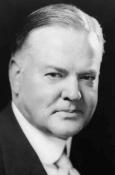
President
Herbert Hoover
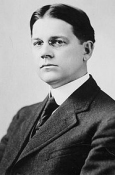
Postmaster General
Walter F. Brown
Music
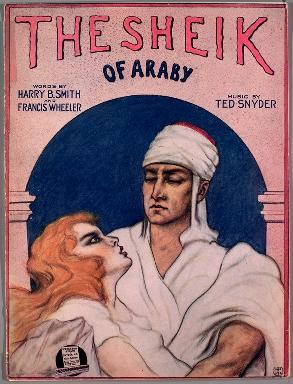
Click Control Above To Hear
1932 "The Sheik Of Araby"
Postage Rates
Domestic Letter Rate
Jan. 1 - Jul. 4:2¢ per oz
Jul. 5 - Dec. 31: 3¢ per oz.
Air Mail Rate
Jan. 1 - Jul. 4: 5¢ per oz
Jul. 5 - Dec. 31: 8¢ per oz.
Stamps
Commemorative Postage Stamps of 1932
400 Subject Plates - Rotary Press
Perf 11 x 10½ (unless otherwise noted)

2¢ Lake Placid Winter Olympics
Flat Plate - First Day: Jan. 25, 1932
Perf 11 - 51,102,800 issued

2¢ Arbor Day
First Day: April 22, 1932
100,869,300 issued

3¢ Sprinter - Summer Olympics
First Day: June 15, 1932
168,885,300 issued

5¢ Myron's Discobolus
First Day: June 15, 1932
52,376,100 issued

3¢ William Penn
First Day: Oct. 24, 1932
49,949,000 issued

3¢ Daniel Webster
First Day: Oct. 24, 1932
49,538,500 issued
The 2¢ Lake Placid - The Winter Olympic Games of 1932
The three Olympic stamps of 1932 continued a tradition of the U.S. Post Office Department issuing postage stamps to promote events. This stamp features the Winter Olympics at Lake Placid, New York. The event did much to raise Lake Placid's status as a resort area, and in fact in 1980 the Winter Olympics were again held here.
First Day sales were in Washington D.C. and, of course, Lake Placid. Even though only two cities were chosen to distribute the First Day Issues, the supply of 400,000 First Day stamps was quickly exhausted. First Day Cover collecting had now become fashionable and the stock of First Day Covers of all of the commemoratives of 1932 is more than adequate to this day, with few exceptions.
The 2¢ Arbor Day Issue of 1932
The first Arbor Day, a state holiday "consecrated to tree planting" in the words of its founder Julius Morton, was held in Nebraska on April 10th, 1872. The planting of trees was to provide shade, shelter, fruit and nuts, fuel, and beauty for the inhabitants of the ninety-seven per cent treeless state. Over one million trees were planted on that first Arbor Day. Over the next few years, the holiday went on to become so popular that many of the neighboring Plains states adopted it.
Through time all of the states have adopted the holiday, although the day of the year Arbor Day falls on varies from state to state, with Florida's as early as January and Hawaii's as late as November. The Northern states would of course need a planting date in late spring or early summer, and this is indeed the case.
As with many of its predecessors, this stamp was a concession to heavy lobbying, in this case from the Midwest, particularly Representative John Morehead of Nebraska. April 22, 1932 marked the 100th anniversary of the birth of Morton and was chosen as the First Day of issue, with First Day sales in Nebraska City, Nebraska.
The 3¢ Sprinter at Starting Mark and The 5¢ "Myron's Discobolus"
Celebrating the 10th Olympiad at Los Angeles
These stamps did not encounter the usual resistance surrounding other new issues of the era in that they promoted the Summer Olympics of 1932 in the same manner that the "ski jumper" stamp above promoted the Winter Olympics. The 3¢ denomination reflected the anticipated increase in first class letter rate from 2¢ to 3¢, which actually took place on July 6 of that year and was printed in the purple of the contemporary three cent stamps. The 5¢ stamp, printed in the blue of the contemporary five cent stamps, reflected the rate for the first ounce of foreign mail, clearly emphasizing the international importance of the Olympic Games. First Day sales for both stamps were on June 15, 1932 in Los Angeles, California and a day later in Washington, D.C. The stamps were very popular as souvenir items and as with all of the commemorative stamps of 1932, sufficient numbers were saved that an adequate supply of both stamps exists today.
The 3¢ William Penn
William Penn is of course well known as the founder of Pennsylvania and the man who designed the City of Philadelphia. Contrary to the common assumption that he named the colony after himself, Pennsylvania, literally meaning "Penn's Woods", was named after his father Sir William Penn. The younger Penn was granted the land west of the Delaware River, what is now called Pennsylvania, as payment for a debt the King of England owed his father. Penn and his fellow Quakers arrived in Pennsylvania in the Fall of 1682.
The founding of Pennsylvania alone would not distinguish Penn in a way that would merit the place he holds in American history. Penn was a spiritual man and became a "Friend", or Quaker, early in life. The Quaker doctrine influenced his political beliefs, and the "Frame of Political Government" he devised for Pennsylvania contained many of the ideals that would later be adopted by the American Constitution. None other than Thomas Jefferson referred to him as "the greatest law-giver the world has produced." His pacifist nature manifested itself in his dealings with native Americans, not only did he try to work peacefully with the locals, but he learned to distinguish the cultural differences and dealt with each tribe accordingly.
It is ironic that the only authentic portrait of the peace-loving Penn is at age 22 in a full set of armor. This is the portrait on which the design of the stamp is based. Fortunately, his armor was replaced by the traditional dress of the day, and although perhaps a little youthful, the stamp portrays him in a peaceful enough light.
It is thought by some that the man on the Quaker Oats box is an older version of William Penn. However this is not the case; to quote the Quaker Oats Company itself, "The "Quaker man" is not an actual person. His image is that of a man dressed in the Quaker garb, chosen because the Quaker faith projected the values of honesty, integrity, purity and strength."
October 24, 1932 marked two anniversaries - October 24 is William Penn's birth date and 1932 marked the 250th anniversary of Penn's settlement in America. First Day sales were in Philadelphia, Chester and New Castle, Pennsylvania.
The 3¢ Daniel Webster
Although not known for any single deed, Daniel Webster was certainly one of the great Americans of the nineteenth century. Variously known as the "Defender of the Constitution" and the "Great Expounder of the Constitution", his love of America and his sense of nationalism at a time when the North and South were heavily divided over slavery and the rights of all mankind, combined with his great oratorical skill, played a key role in delaying the inevitable Civil War which ultimately started less than a decade after his death.
He served as a senator from Massachusetts, as Secretary of State under William Harrison, and ran for President as the Whig party nominee, among a great many other things. He is often quoted, we found 38 quotations in Bartlett's Familiar Quotations, including one that rings eerily familiar to anyone familiar with Lincoln's Gettysburg Address - "The people s government, made for the people, made by the people, and answerable to the people." This in a speech made in 1830, more than 30 years before Lincoln expressed nearly the same sentiments at Gettysburg.
Although the portrait on this stamp may not ring familiar, this is the same Daniel Webster honored on three earlier stamp designs: the 15¢ BankNote of the 1870 design, the 10¢ Baby Banknote and "Triangle", and the 10¢ stamp of the 1902 Series. The designer of the portrait obviously took quite a bit of artistic liberty with this stamp, since Webster was also known as "Black Dan" for his thick head of black hair and a dark complexion.
Today, many Americans have forgotten the important role Daniel Webster has played in the shaping of American history. His presence on four of the first 250 or so designs of American postage stamps should help to reinforce this fact. And in case you were wondering, Daniel was of no relation to Noah Webster of the "Webster's Dictionary" fame.
October 24, 1932 marked the 80th anniversary of Webster's death. The issue of this stamp was to coincide with the unveiling of a memorial bust to honor him, but the famous sculptor, Daniel Chester French, died before he completed it. First Day sales were in Franklin, Webster's birth place; Exeter, the home of Philips Exeter Academy where Webster was schooled; and Hanover, the site of Webster's alma mater Dartmouth College, all in New Hampshire.
The Air Mail Stamp of 1932
Rotary Press - Perforated 10½ x 11 - 200 Subject Plates

8¢ Olive Bister Winged Globe
First Day: September 26, 1932
about 72 million issued
On July 6, 1932 the rate for a one ounce letter delivered via airmail increased from 5¢ to 8¢. This stamp was issued more than two months after the rate change. In the meantime, the eight cent rate had to be made up with the ordinary 2¢ and 3¢ postage stamps. Additional weight carried a premium of 13¢ per ounce, but a thirteen cent airmail stamp was never issued to meet this need.
First Day sales were at the Philatelic Agency in Washington, D.C. with a special cachet being designed for the "First Flight" covers.
The Ordinary Postage Stamps of 1932
Rotary Press

3¢ "Stuart" Washington
First Day: June 16, 1932
400 Subject Plates
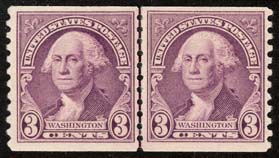
3¢ Washington Horizontal Coil
First Day: June 24, 1932
Perf 10 Vertically - Joint Line Pair

3¢ Washington Vertical Coil
First Day: Oct. 12, 1932
Perf 10 Horizontally
This stamp can be a little confusing for collectors of U.S. stamps. If you think it looks a lot like the 2¢ red of the Washington Bicentennial Issue of 1932, you're right. It is nearly identical, except it was printed in the purple of the three cent stamps of the day, the "1732" and the "1932" and the ribbons were removed and of course the denomination was changed from two cents to three cents. The stamp was needed to meet the rate increase from 2¢ to 3¢ on July 6 of that year.
Although it looks like it belongs to the Washington Bicentennial set, it does not. The Bicentennial commemoratives had their own three cent stamp, and in fact that design had been considered for the ordinary stamp. However, the universally known Stuart portrait on the two cent stamp was deemed much more pleasing and was chosen for the regular issue instead, in fact so pleasing that it is also the basis for the portrait on the bill for which much of the world-wide economy is based, the American dollar, although on the dollar bill Washington is facing left and on the stamp, right.
This issue is a favorite of the so-called "flyspeck" philatelists, the number of shifts, transfers and recuts is that great. There are collectible varieties with gripper cracks, horizontal and vertical gutters, as well as horizontally imperforate vertical pairs. Shade varieties run from a reddish violet in the earlier printings to a bluish violet in the later printings. Being a regularly issued stamp, this stamp was also issued in coil and booklet form.
First Day sales for all three varieties shown above, as well as the booklet pane, were in Washington, D.C. The First Day Cover of the booklet pane is somewhat scarce and brings a substantial premium.
The 6¢ Garfield Rotary Press Coil of 1932
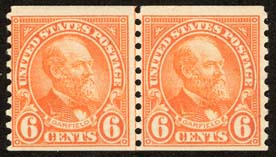
6¢ Garfield Coil Stamp
First Day: Aug. 18, 1932
Perf 10 Vertically - Joint Line Pair
The rate increase from 2¢ to 3¢ on July 6 of 1932, as with the 3¢ stamp above, necessitated a 6¢ stamp to cover the cost of mailing a letter weighing up to two ounces, the double letter rate. This was the last of the Series of 1922 stamps to be issued and completes the set. First Day Sales on August 18 were at the American Philatelic Society's Annual Stamp Convention, held that year in Los Angeles and a day later on August 19 in Washington, D.C. The August 18 Los Angeles covers with the Philatelic Station cancel bring a small premium over their August 19 counterparts.
This stamp, as with all coil stamps, is best collected in pairs. The joint line pairs are somewhat scarce and bring a nice premium over the ordinary coil pair.
The following postage stamp varieties were first issued by the U.S. in 1932
Ordinary issue
Number 720 - 3¢ Washington Perf 11 x 10½
Number 720b - 3¢ Washington Perf 11 x 10½ Booklet Pane
Number 721 - 3¢ Washington Rotary Coil Perf 10 Vertically
Number 722 - 3¢ Washington Rotary Coil Perf 10 Horizontally
Number 723 - 6¢ Garfield Rotary Coil Perf 10 Vertically - see: Issues of 1922
Commemoratives
see also: Washington Bicentennial Stamps of 1932
Number 704 - ½¢ Washington Bicentennial - Designer: C. A. Huston - Engravers: J. C. Benzing (vignette) & D. R. McLeod (lettering)
Number 705 - 1¢ Washington Bicentennial - Designer: A. R. Meissner - Engravers: J. Eissler(vignette) - E. H. Helmuth (lettering)
Number 706 - 1½¢ Washington Bicentennial - Designer: C. A. Huston - Engravers: J. C. Benzing (vignette) & W. B. Wells(lettering)
Number 707 - 2¢ Washington Bicentennial - Designer: C. A. Huston - Engravers: J. Eissler (vignette) & E. M. Hall (lettering)
Number 708 - 3¢ Washington Bicentennial - Designer: C. A. Huston - Engravers: J. C. Benzing (vignette) & D. R. McLeod (lettering)
Number 709 - 4¢ Washington Bicentennial - Designer: A. R. Meissner - Engravers: J. C. Benzing (vignette) - F. Lamasure (lettering)
Number 710 - 5¢ Washington Bicentennial - Designer: A. R. Meissner - Engravers: J. Eissler (vignette) - H. S. Nutter (lettering)
Number 711 - 6¢ Washington Bicentennial - Designer: C. A. Huston - Engravers: L. S. Schofield (vignette) & E. M. Hall (lettering)
Number 712 - 7¢ Washington Bicentennial - Designer: A. Meissner - Engravers: L. Schofield (vignette) & E. H. Helmuth (lettering)
Number 713 - 8¢ Washington Bicentennial - Designer: C. A. Huston - Engravers: E. J. Hein (vignette) & W. B. Wells lettering)
Number 714 - 9¢ Washington Bicentennial - Designer: C. A. Huston - Engravers: Schofield (vignette) - E. M. Hall (lettering)
Number 715 - 10¢ Washington Bicentennial - Designer: A. R. Meissner - Engravers: J. Eissler vignette) - E. M. Hall (lettering)
Number 716 - The 2¢ Lake Placid - Designer: A. R. Meissner - Engravers: John Eissler (vignette) & Edward M. Hall lettering)
Number 717 - The 2¢ Arbor Day - Designer: A. R. Meissner - Engravers: John Eissler (vignette) & Edward M. Hall lettering)
Number 718 - The 3¢ Olympic Runner - Designer: V. S. McCloskey, Jr. - Engravers: J. Eissler (vignette) & E. M. Hall (lettering)
Number 719 - The 5¢ Discus Thrower - Designer: V. S. McCloskey, Jr. - Engravers: J. Eissler (vignette) & E. M. Hall (lettering)
Number 724 - The 3¢ William Penn - Designer: A. R. Meissner - Engravers: John Eissler (vignette) & Edward M. Hall (lettering)
Number 725 - The 3¢ Daniel Webster - Designer: C. Aubrey Huston - Engravers: J. Eissler (vignette) & W. B. Wells(lettering)
Air Mail
Number C17 - The 8¢ Olive Bistre Winged Globe
Special Delivery
There were no new Special Delivery Stamps Issued in 1932
Postage Dues
Rotary Press - Carmine - Perf 11 x 10½
Number J80 - The 1¢- "Dry Printing" - date of issue unknown
Number J84 - The 10¢ - October 29, 1930
Number J85 - The 30¢ - October 18, 1932
Number J86 - The 50¢ - November 16, 1932





